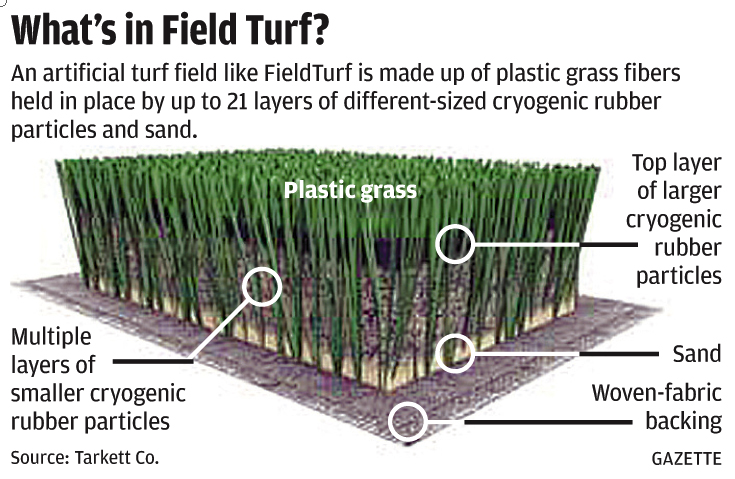What are the options? Synthetic turf, or not—that is the question.
By Dorothy Wigmore
Government agencies, schools and parents want to know what harm artificial surfaces can cause. Present in thousands of playgrounds, athletic fields and other spaces, at least four states have considered bills to ban or restrict their use.
Concerns often center on children using the surfaces. With rapidly developing systems, their bodies are not fully ready to fend off toxic substances. They breathe more air per unit of body weight than adults. They are more likely than adults to get dirt on their hands and then into their mouths.
What is artificial turf?
First introduced in the 1960s, current artificial turf products include playground mulch, poured-in-place playgrounds with rubber waste bases, and infill on synthetic grass athletic fields, golf courses, and indoor playing surfaces. The current generation of these products is based on the tire industry’s response to the late 1990s billion-plus discarded tire problem—grind them up as an alternative for playground dirt and call it “rubber.”
There are no standards for synthetic turf content. The industry pitches its outdoor product as an “eco-friendly solution.” It also maintains there is no evidence the rubber particles are harmful, despite their many known toxic ingredients.
“Dorothy Wigmore is a long-time health and safety specialist, trained in occupational hygiene, ergonomics, work organization/stress and education. A Canadian, she has worked also in the U.S. and Mozambique, and been involved in efforts to prevent and deal with job-related hazards for many years.”
What are the questions, concerns?
It’s difficult to determine everything in the rubber particles or other turf parts.
“There’s an abundance of hazards baked into the material, and we know that they’re not inert and are released over time,” says the Ecology Center’s research director, Jeff Gearhart. “We don’t think people fully understand the complexity of this material we’re distributing into children’s playgrounds and surfaces people play on.”
In May, the Ecology Center reported finding very high lead levels in the shredded tire rubber waste fill in a Washington, D.C.-area school playground. Earlier this year, a study identified 306 ingredients in “crumb rubber,” 192 of which are predicted to cause cancer. Polycyclic aromatic hydrocarbons (PAHs) are one of the main concerns. In June, the European Chemical Agency (ECHA) proposed restricting the use of PAH “granules and ‘mulches’ used as infill material in synthetic turf pitches and in loose forms on playgrounds and in sports applications.”
“We know there are many hazardous chemicals and metals in the “crumbs” and other components.”
In July, a U.S. Environmental Protection Agency (EPA) report about turf recycled crumb rubber ingredients looked for 21 metals and 80 chemicals. The Ecology Center and another nongovernmental organization want the EPA to retract its findings because of “inaccurate, incomplete, and unreliable information” and an unsubstantiated conclusion that there is little to worry about.
In contrast, Harvard University’s Dr. Stuart Shalat describes the “Pigpen Effect”—the cloud stirred up by activity on a synthetic surface. Based on his studies, “casual sampling of fields massively underestimates” what children likely are breathing.
Besides carcinogens, shredded tire products include known endocrine disruptors, neurotoxins, and respiratory, eye, and skin irritants. Other questions focus on the environmental consequences of microplastics from the grass and runoff from outdoor fields.
“Turf burn” scrapes can be complicated if the surface’s dust gets into an open wound. Several studies have found increased injuries on artificial surfaces, depending on the sport, footwear and other factors. The surfaces get hot easily; recorded temperatures can reach above 130 F and are more likely to give off volatile toxic chemicals. Heat-related illnesses from playing or coaching on the fields can be very serious.
“A lot of the marketing around crumb rubber fields has been very misleading,” says Mount Sinai public health and pediatrics professor, Dr. Philip Landrigan. “The companies that are marketing the fields don’t talk about the heat hazards, they don’t talk about the chemical hazards, they don’t talk about the costs that are going to be associated with dismantling the fields when they reach the end of their natural life span, when they must be treated as hazardous waste.”

There are better solutions
Rather than arguing about how much exposure occurs from synthetic turf, use precaution with informed substitutes.
“A much better solution is to build fields that are properly elevated, properly drained and that are planted with tough species of grass that don’t require pesticides,” Landrigan says. That’s doable. Most of those new substitutes have not been very carefully tested for their safety, so we don’t really know what they might contain.”
The Massachusetts Toxics Use Reduction Institute (TURI) says the same thing. Its 2019 report concludes: “From an environmental and health standpoint, organically managed natural grass is a safer choice for sports fields. When the full product life cycle is considered, organically managed natural grass also offers lower costs over time.”
For playgrounds, the Ecology Center recommends untreated virgin engineered wood fiber.
Resources
US EPA
Federal research on recycled tire crumb used on playing fields.
Toxics Use Reduction Institute (TURI)
Artificial turf: safer alternatives report, resources, videos, and more.